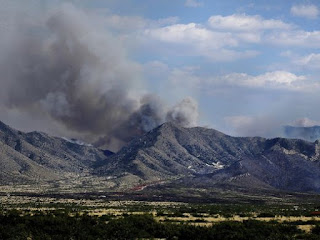More than 8,000 firefighters across the West battled dozens of wildfires Thursday that forced thousands of local residents to pack up families, pets and personal treasures to flee the advancing blazes.
Thirty large fires were burning nearly 180,000 acres, the National Interagency Fire Center reported, as the region continued to pay a steep price for a recent, record-smashing heat wave that combined with low humidity and wind to create a perfect storm for wildfires.
More than 4,200 square miles have burned so far this year, almost the size of Connecticut and 30% more than 2016's year-to-date total.
In Arizona, the Goodwin Fire about 100 miles north of Phoenix was one of six large fires burning across the state. Dewey-Humboldt resident Terry Thompson squeezed five people, four dogs and two cats into a 2005 Jeep Liberty not long after his wife, Angie, picked up the phone to hear the recorded evacuation notice.
Like hundreds of others displaced or left on edge by the 21,000-acre wildfire, the Thompsons had to keep ahead of the blaze, which was listed as just 1% contained early Thursday.
"I'm still in shock," Terry Thompson said. Angie Thompson grabbed some keepsakes on their way out the door: "photos, photo albums, our safe. Oh, and baby shoes. Bronze baby shoes."
The fire center warned that for the next couple days the fire had a "high spread potential ... with southwest winds of 15-20 mph and gusts up to 30." Gov. Doug Ducey declared a state of emergency and said he would visit the area Thursday.
The fire follows more than a week of record-setting high temperatures across much of the West. Phoenix set a string of daily records last week and reached 119 degrees one day. Temps have eased, but summer remains summer — this week's daily highs have been a more seasonal 108 degrees.
The nation's largest fire, the Brian Head Fire, has been burning for almost two weeks in southwestern Utah, 250 miles south of Salt Lake City. The fire had consumed more than 50,000 acres early Thursday and was 10% contained.
There was good news for some locals when the town manager in Brian Head announced that the evacuation order put in place July 17 was scheduled to be lifted Friday — just in time for a holiday weekend celebration that won't include fireworks.
Some area communities won't be so lucky, but Brian Head Town Manager Bret Howser said power was restored and Internet and phone repairs were expected to be completed sometime Friday.
"We invite everybody to come share in our Independence Day celebrations, thank the brave firefighters, help our local businesses recover and see how beautiful Brian Head still is!" Howser said in a Facebook post.
The news was also brighter near Burbank, Calif., where scores of home were ordered evacuated Wednesday ahead of a small but fierce wildfire. Firefighters quickly gained control of the blaze, and the evacuation order was lifted hours later.
===============
A series of wildfires is blazing across the Southwest as the chance of rain remains low amid a deadly heatwave.

Officials view the Brian Head Fire in Utah from near Brian Head Peak on June 23, 2017. (Credit: Utah Fire Info / Facebook)
Eighteen large fires are burning in the region, including six in Arizona, three in Utah, three in California, three in New Mexico and two in Nevada. One large wildfire is burning in Oregon. The two biggest of those are in southern Arizona and Utah.
Wildfires already have caused far more destruction than usual in the first half of 2017, meteorologist Haley Brink of the CNN Weather Center said. Almost 1 million more acres had burned by Thursday, compared with the 10-year average through June 22.
800 battle Arizona wildfire
The Frye Fire in southern Arizona covers nearly 30,000 acres and is only 10% contained, the forest service at Coronado National Forest said.
More than 800 personnel are battling the fire, which started on June 7. The Frye Fire is about 70 miles northeast of Tucson, the second-largest city in Arizona.
Gov. Doug Ducey declared a state of emergency Friday in Arizona to authorize the use of $200,000 of emergency funds to counter increased wildfire activity.
Since April, the state has experienced more than a dozen large wildfires “aided by high temperatures, winds, and available fuels,” his office said in a statement.
“We thank the many brave men and women who have stepped up and responded to wildfires around Arizona,” Ducey said. “I’m issuing today’s declaration to make sure they have every resource needed to do their jobs and protect our communities.”
The area near the fire is expecting temperatures in the triple digits through next Friday, with no sign of rain.
13 homes destroyed in Utah
In Utah, too, raging fires continue to blaze with little rain relief in sight.
Nine communities, including Brian Head, a ski town near the Dixie National Forest in the southern part of the state, have been evacuated, officials said. At least 13 homes and eight outbuildings have been destroyed in Brian Head, which is about 30 miles north of Zion National Park.
The massive Brian Head wildfire has grown to 33,000 acres and is just 5% contained, the Utah Division of Forestry said. More than 800 personnel are tending to the fire.
The fire started on June 17 and “grew very quickly through dense timber,” officials said.
Temperatures in Brian Head are expected to be fairly moderate, in the low 70s and upper 60s, through Friday, but no rain is in sight.
Other fires
Aside from those two major fires, 16 other active fires of lesser size blazed around the West.
In New Mexico, the Corral Fire reached about 17,000 acres and is burning with low to moderate intensity, according to New Mexico Fire Information.
And in central Oregon, the Rhoades Canyon fire grew to 14,000 acres but was 50% contained, according to CNN affiliate KTVZ.










